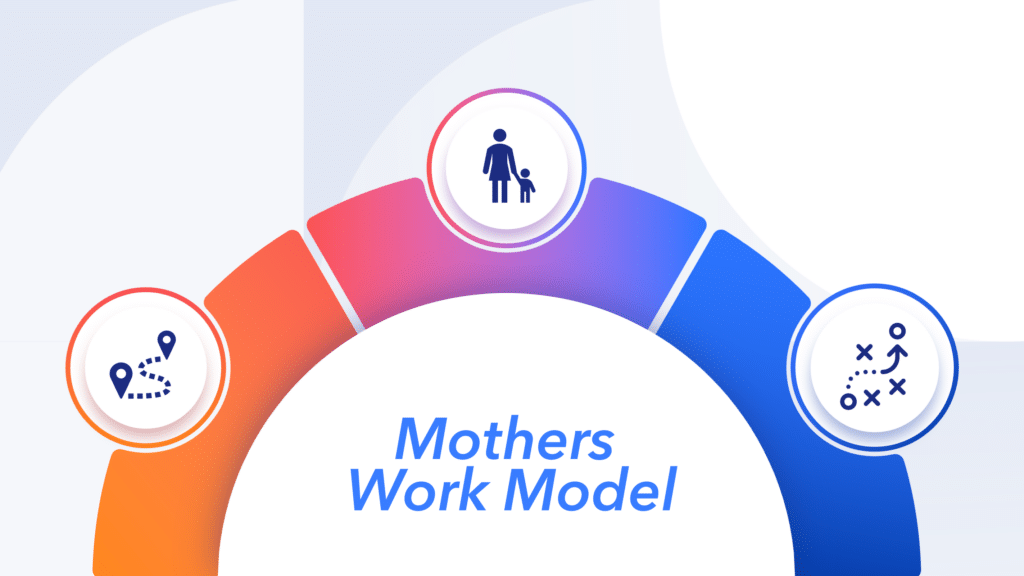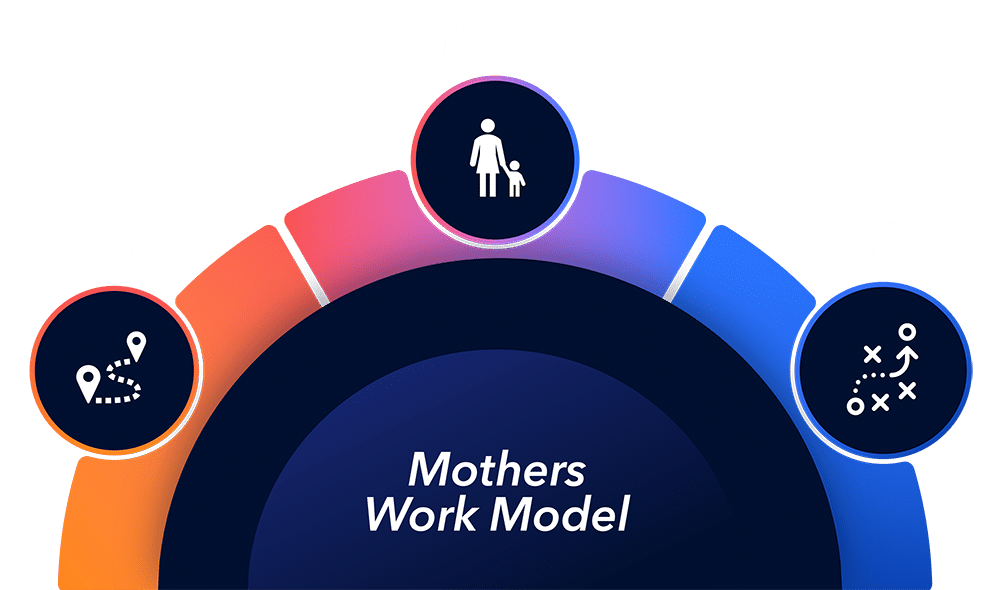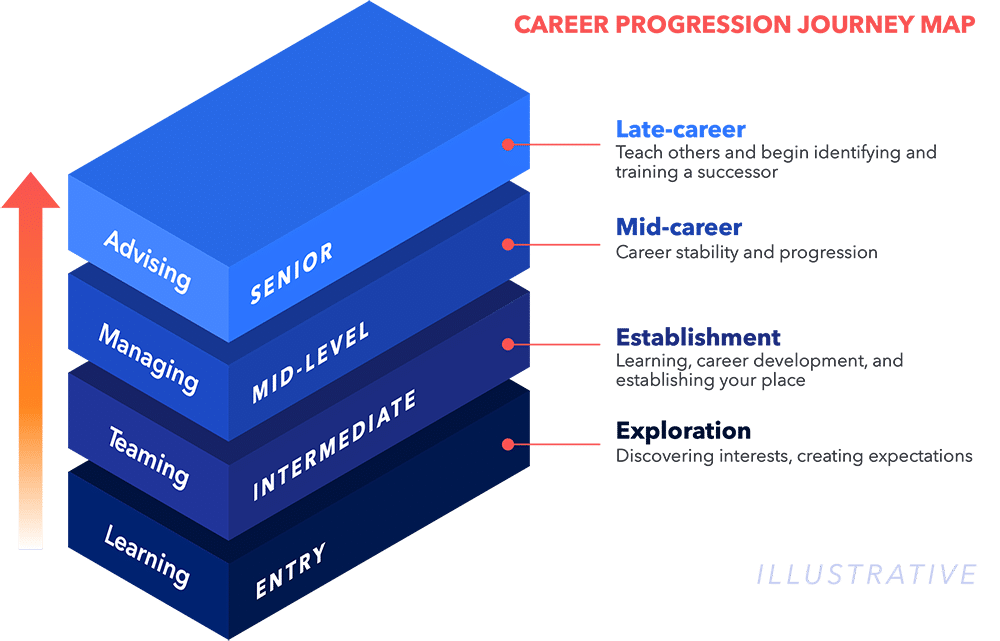FRAMEWORK
Transforming Workplace Support with the Mothers Work Model
- The departure of working mothers from leadership roles threatens diversity and organizational success. The Mothers Work model offers tailored support, empowering high-performing women to navigate career aspirations and motherhood with success.


In today’s corporate culture, the presence of women in leadership enriches an organization and drives its success.
The desire to elevate women within the corporate structure has never been more pronounced, with an increasing number of companies recognizing the value they bring to the table. However, a grim reality is emerging—one that sees working mothers stepping away from the corporate world despite their invaluable contributions and potential.
Imagine the void left by a colleague, perhaps someone you’ve admired or mentored, as they grapple with the daunting task of juggling the demands of motherhood with the rigors of a leadership role.
of high-performing women want children1
of highly skilled women leave the workforce after becoming mothers1
of Millennial women report making a change to their work status after becoming a mother3
This scenario is far from an anomaly. The data overwhelmingly supports the notion that the loss of women, especially those in leadership positions, poses a severe threat to diversity within organizations. Additionally, the repercussions go far beyond financial figures, ranging from half to three times her salary, translating to a significant financial blow to the organization. Moreover, there’s an unrealized effort in hiring and retaining women, a process that demands intentional and strategic approaches to create environments where working mothers don’t just survive but thrive.
In navigating the intricate balance of professional growth and motherhood, organizations increasingly recognize the imperative for a tailored support system that effectively supports, advances, and retains working mothers. So, where do we go from here?
A model to address the needs of working mothers
A recent article in the Harvard Business Review highlighted the significance of female mentors and colleagues in retaining women within organizations. The absence of such support may lead working mothers to question their fit in a work environment that appears incongruent with their roles at home.
Conventional organizational approaches often fall short, applying a generic, one-size-fits-all strategy for working mothers. It’s time for a fundamental shift in perspective and a commitment to understanding the nuanced intersection of work and motherhood. This is where Pariveda’s Mothers Work (MW) model steps in, offering a comprehensive and nuanced approach to address the unique needs of working mothers.

Component 1
Career Progression
Organizations need to define and communicate clear career paths, ensuring that employees, especially mothers, understand the expectations at each stage of their journey. By removing ambiguity, organizations enable working mothers to anticipate and plan for milestones, cultivating a supportive environment.
Implementing a structured career progression model provides a roadmap for mothers to navigate their professional journey while balancing familial responsibilities. Clear communication of expectations at each stage fosters an environment where working mothers feel empowered, reducing uncertainty and promoting a sense of control over their career trajectory.


Component 2
Stages of Motherhood Framework
The Stages of Motherhood (SOM) framework recognizes that motherhood is a lifelong journey, not confined to the early stages. By understanding the unique challenges and demands of each stage, organizations can tailor their support to match the needs of working mothers, preventing the loss of valuable talent. The SOM framework identifies three condition measures—Cognitive, Physical, and Emotional—that impact mothers at each stage.
Early motherhood, school-age children, teenage years, and the empty nest syndrome – each stage presents distinct challenges and opportunities for working mothers. The SOM framework allows organizations to gain a comprehensive understanding of the multifaceted experiences these women undergo, facilitating targeted support mechanisms that resonate with their specific needs. This holistic approach acknowledges the evolving nature of motherhood and ensures that organizations remain adaptive and responsive.
Component 3
Employer Strategies and Interventions
Through extensive research, five impactful strategies have been identified:
- Competitive Policies
- Employer Assistance & Benefits
- Employer Flexibility
- Work Preferences
- Financial Support
Flexibility, highlighted as a primary driver for attracting mothers, goes beyond remote work. Organizations need to foster an environment where unique flexibility needs are supported and decisions are based on business needs rather than assumptions about commitment and productivity.

Flexible work arrangements, competitive policies, financial support, targeted assistance & benefits, and accommodation of work preferences collectively contribute to creating a supportive organizational culture. By implementing these strategies, organizations not only demonstrate their commitment to working mothers but also create an inclusive environment that values diverse perspectives. This approach fosters a culture that retains high-performing women and also serves as a proactive measure to ensure workplace harmony.
Transforming workplaces for mothers
The MW model presents these components as interconnected elements that empower organizations to address working mothers’ challenges proactively. By considering their unique career progression journey and overlaying the insights from the SOM framework, organizations can identify hotspots where targeted interventions will have the most significant impact on retention.
While implementing the MW model at your organization may incur costs, the long-term benefits far outweigh the expenses. Retaining high-performing women within the organization saves money compared to external hires and positions these women as three times more likely to succeed as future leaders.
As organizations delve into the complexities of this paradigm shift and strive to support, advance, and retain working mothers, the MW model prompts further exploration and commitment to creating workplaces that truly embrace the diverse and multifaceted experiences of working mothers.
Embrace the three-component approach and join the movement towards a more inclusive and supportive professional landscape for working mothers.
Case Studies
Explore our success stories
INSIGHTS


Article
Perspectives

Article
Perspectives


















